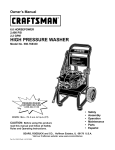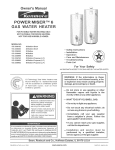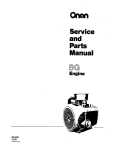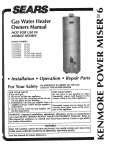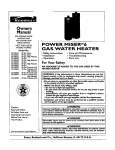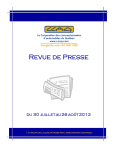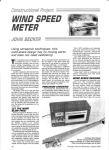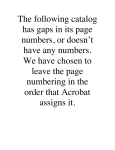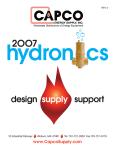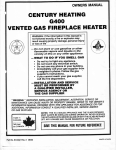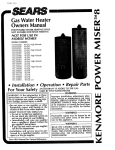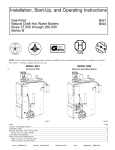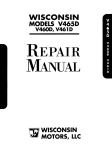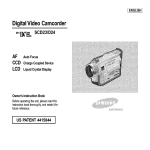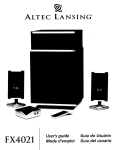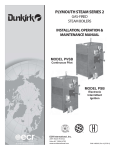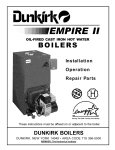Download JVC DR-DX5SE Universal Remote User Manual
Transcript
OWNER'S
MANUAL
CONTINUOUS
PILOT
MODEL NO.
KWX
- 3V
KWX - 4V
KWX
- 5V
KWX
- 6V
KWX
- 7V
KWX
- 8V
KWX
- 9V
Gas- Fired
Cast Iron
HOT WATER
BOILER
• Installation
CAUTION
• Operation
Read all instructions
• Repair Parts
carefullybefore
starting
the installation.
Save this manual
for future reference.
These instructions
must
be affixed on or adjacent
to the boiler.
Sears,
Roebuck
WAILING:
Improper installation, adjustment, alteration, service or
maintenance
can cause injury or property damage. Refer to this
manual. For assistance or additional information consult a qualified
installer, service agency or the gas supplier.
and Co., Hoffman
Estates,
IL 60179 U.S.A
I
KENNMORE CAST IRON BOILERS
FULL ONE YEAR WARRANTY ON HOT WATER AND GAS STEAM CAST IRON BOILERS
For one (1) year from the date of installation, when this boiler is installed and maintained in accordance
with our instructions. Sears willrepair defects in material or workmanship in the boiler,free of charge.
LIMITED 12 YEAR WARRANTY ON STEAM CAST IRON BOILERS
After one (1)year and through twelve (12) years from the date of installation,Sears will furnish a replacement
:_
heat exchanger, if the heat exchanger in the boiler is defective. YOU PAY FOR LABOR.
LIMITED 20 YEAR WARRANTY ON HOT WATER CAST IRON BOILERS
After one (1) year and through twenty (20) years from the date of installation,Sears will furnish a replacement
heat exchanger if the heat exchanger in the boiler is defective. YOU PAY FOR LABOR.
SEARS INSTALLATION WARRANTY
;_
In addition to any warranty extended to you on the Sears merchandise involved, which warranty becomes
effective the date the merchandise is installed, should the workmanship of any Sears arranged installation
prove faulty within one year, Sears will, upon notice from you, cause such faults to be corrected at
;_l
no additional cost to you.
FOR WARRANTY SERVICE, SIMPLY CONTACT THE NEAREST SEARS STORE OR SERVICE
CENTER THROUGHOUT THE UNITED STATES. This warranty gives you specific legal rights, and
you may also have other rights which vary from state to state.
i
IMPORTANT
The following are the responsibilities of the user and are not
covered by the Warranty
5. If the unit is removed from the place it was originally installed,
this VCarranty
becomes void.
1. Filter clearing or replacement.
6. Damage to the unit caused by accident, abuse, negligence,
misuse, riot, fire, flood, or acts of God.
2. Damage to unit or unsatisfactory operation due to improper
cleaning or use of unit in corrosive atmosphere.
3. Damage to unit or unsatisfactory operation due to blown fuses
or inadequate or interrupted electrical protective devices.
SEARS ROEBUCKAND COMPANY
D/817WA
Hoffman Estates,IL 60179
4. Damage to unit caused by the use of components or other
accessories not compatible with the unit.
1 Read the Owner's Manual for Safe Operation carefully Failure
to follow the rules for safe operation and the instructions can
cause a malfunction of the boiler and result in death, serious
bodily injury, and/or property damage.
check all connections. This will avoid any possibility of fire
or explosion
5. Be certain your new boiler will be using the correct gas.
Overfiring will result in premature failure of the boiler sections
and cause dangerous operation
2 Check your local cedes and utility requirements before
installation. The installation must be in acordance with their
directives.
6. Never vent this boiler into an enclosed space. Always vent
to the outside. Never vent to another room or inside a building
3. Before servicing, allow boiler to cool. Always shut off any
electricity and gas to boiler when working on it. This will prevent
any electrical shocks or burns.
7. Be sure there is adequate air supply for complete combustion
8 Follow a regular service and maintenance schedule for efficient
and safe operation.
4 Never test for gas leaks with an open flame. Use soap and
2
FIG. 1
-ASME R[[J_¥
VALVE
DAMPER
C_
--A
VI£NT
II
,-_ .....
I;[ HPT
?
!
, \
"_
i
II
ENCLOSED
SCOHTROL_
-I,
[_----J
i<\/
I
I
I
i
\
\.A
I
I
I
I
i
I
JI
• _AJN VALVE %
_._L_
_.1__ _1__
_
GAS VALVE
COH_OL
L
GAUGE
hr_
l
l
r---
TEMP./PRESS.
u
......
,.Lr'--_l_ [
i
31
?
LEFT S;DE
®
RIGHT SIO[
BASIC BOILER MODEL NO.
ConUnuous
With
r' 'E'r'PPLE
Pilot
NATURAL
NO. OF
SECTIONS
Vent Damper
KWX-3V
KWX-4V
KWX-5V
KWX-6V
KWX-7V
KWX-8V
KWX-9V
AGA/CGA
INPUT
*MBH
3
4
5
6
7
8
9
70
105
140
175
210
245
280
HEATING
CAPACITY
*MBH
57
85
113
142
170
198
226
GAS
DIMENSIONS
NET
I=B=R
FLUE
DIAMETER
(INCHES)
"A"
WIDTH
Ratin9*MBH
5O
74
98
123
148
172
197
5
6
6
7
7
7
7
11 1/4
14 1/2
17 ¾
21
24 1/4
27 1/2
30 ¾
* MBH = 1,000 Btuh
Btuh = British Thermal Unit Per Hour
For altitudes above 2,000 ft. ratings should be reduced at the rate of 4a_ for each 1,000 ft. above sea level•
Heating Capacity is based on D.O.E (Deparirnent of Energy) test procedure.
**Add 5 ½" to height for Vent Damper.
The Ratings marked "Net I=B-R Ratings" indicate the amount of remaining heat input that can be used to heat the radiation or terminal
Units. The net I=B=R Ratings shown are based on an allowance of 1.15 in accordance with the factors shown on the I=B=R Standard
as published by the Hydronies Institute.
Selection of boiler size should be based upon "Net I=B=R Rating" being equal to or greater
than the calculated heat loss of the building.
The Manufacturer
should be consulted before selecting a boiler for installations having
unusual piping and pickup requirements.
These boilers must stand on a non-combustible
floor. If installed on a combustible floor, use
Combustible
Floor Base Number 42135-1 or 146-14-031 (3-6 section boilers) or 42135-2 or 146-14-032 (7-9 section boilers).
BOILERS
FOR
USE AT HIGH
ALTITUDE
This boiler is factory equipped for use at altitudes of 0-2,000
ratings are reduced by a change in main orifice size.
feet above sea level.
For use at altitudes
above sea level, the input
For altitudes above 2,000 feet above sea level, input ratings should be reduced at the rate of 4% for each 1,000 feet
above sea level. Consult the National Fuel Gas Code (NFPA54/ANSI
Z223.1-1atest edition), or the manufacturer
for correct orifice
sizing information.
High altitude orifices are available from the boiler manufacturer.
CheckIo besureyouhavetherightsizeboilerbeforestartingtheinstallation.
Seeratingandcapacitytableon previouspage.Alsobesurethenewboiler is
forthetypeofgasyouareusing.Checktheratingplateon therightsideof the
boiler.
Youmustseethat theboiler is suppliedwith thecorredtypeol gas,freshair
forcombustion,
anda suitableelectricalsupply.Also,theboilermustbeconnectedtoa suitableventingsystemandanadequate
pipingsystem.Finally,a
thermostat,
properlylocated,is neededforcontroloftheheatingsystem.Ifyou
haveanydoubtsasto thevariousrequirements,
checkwith localauthorities
andobtainprofessionalhelpwhereneeded.Takethetime to completeall of
thestepsfor SAFEandPROPER
operationof theheatingsystem.
If thisboileris installedin a buildingunderconstruction,
specialcaremustbe
takento insurea cleancombustionair supplyduringtheconstructionprocess.
Airborneparticulates
suchasfromdrywalldustandlromfiberglassinsulation
canclogtheburnerportsandcauseincomplete
combustionandsooting.
Whererequiredbytheauthorityhavingjurisdiction,theinstallationmustconformto AmericanSocietyof Mechanical
Engineers
SafetyCodefor Control_
andSaletyDevicesfor Automatically
FiredBoilers,No. CSD-1.
The installationmustconformto therequirements
ol the authorityhaving
jurisdictionor,in theabsenceof suchrequirements,
totheNationalFuelGas
Code,ANSIZ223.1-1atest
revision.
Installers- Followlocalregulationswith respectto installationof CO
detectors.Follow maintenancerecommendations
in this instruction
manual.
Tecbniciens
- Veuillezvous conformerd la reglementation
en vigueur
coneemant
I" installationdesdefecteurs
d'oxydedecarbone.Suivreles
consignesd'entretienfigurantdansle manueldinstrudioncijoinL
I KEEP BOILER
AREA
CLEAN
AND
FREE FROMVAPORS
COMBUSTIBLE
MATERIALS,
GASOLINE
AND
OTHER
FLAMMABLE
AND LIQUIDS
1. Selecllevellocationascentralized
with pipingsystem,andasnearchimney,as possible.
2. Placecratedboiler at selectedlocation,removecrateby pulling crate
sidesfromtopand bottomboards.Combustiblefloors:Whenboileris to
be installedon a combustiblefloor,a SpecialBasePlatemustbe used146-14-031(2-6 Section)or 146-14-032(7-9 Section).Thisboilermust
not beinstalledon carpeting.
7. Theboilershall beinstalled
suchthattheautomaticgasignitionsystem
components
areprotectedfromwater(dripping,spraying,rain,etc.)during applianceoperationand service(condensate
trap, controlreplacement,etc.).
FIG, 2 -
MINIMUM
3. Boileris to be level.Metalshimsmaybe usedunderbaselegsfor final
leveling.
4. Additionalclearancesfor servicemayexceedclearances
for fire proteclion. Alwayscomplywith lhe minimumfire prolectionclearances
shown
on the boiler.An !8 inch clearanceshould be maintainedon anyside
wherepassageis requiredtoaccessanothersideforcleaning,servicing,
inspectionor replacement
of anypartthat mayneedattention.
Figure 2 shows minimum clearancesto combustibleconstruction.
Roomsthatare largein comparisonwith thesizeoftheboileraredefined
as roomshavinga volumeequaltoor greaterthan16 timesthevolume
ol theboiler.Wheretheactualceilingheightol a roomis greaterthat8',
lhe volumeol a roomshall be bguredon thebasisota ceilingheightof
8' Determinationof roomsizeshouldbebasedonthetotalvolumeof all
gasfiredequipmentinslalledin theroom.Consultsection6.3.1 of the
NationalFuel Gas Code lot furtherinlormatfon,including.approved
methods[or reducingclearancesin largerooms
5 Equipmentshat!be installedin a locationin whichthetacibliesfor yen
tilationpermitsatistaclorycembushenof gas,propervenbng,andmain
tenanceo! ambientlempe_alure
at safelimitsundernormalcondibonsoi
use £qulpmentshal! be locatedso asnot to interferewdhpropercirculationo[ air Whennormalinlfltrabondoesnotprovidethenecessaryair,
outside ai_ shall be introduced (See Page 4 - Fresh Air for
Combusbon")
6 AdviseownerIo keepair passagesfreeof obstrucbons.VenblaPngand
combusbonair musl enterboilerroomwithoul reskictions
TOP
REAR
RIGHT SIDE
LEFT SIDE
FRONT
FLUE/VENT
CONNECTOR
NEAR BOILER
PIPING
BOILER SIZE
CLEARANCE
DTMENSIONS
Room Large
Alcove, or Room not Large
Comparison
in Comparison with Boiler
With B6iier
3-5 SECT.
6-9SECT.
3-9 SECT.
6"
6"
6"
6"
6"
6"
6"
24"
6"
6"
24"
6"
18"
18"
18"
6 tl
i
1"
u
BOILER
VOLUME
(Cu.Ft.)
3 SECT.
4 SECT.
5 SECT.
6 SECT.
7 SECT.
8 SECT.
5.4
7.0
8.5
10.1
11.7
13.2
9 SECT.
14.8
6 t,
rq
1"
MINIMUM
ROOM VOLUME
REQUIRED TO BE LARGE
ROOM (Cu. Ft.) _
86.6
111.6
136.6
161.7
186.7
211.7
236,7
FOR ROOM WITH SINGLE BOILER ONLY
THIS UNIT MUST BE SET ON A CONCRETE
NON-COMBUSTIBLE
MATERIAL
OR OTHER
BASE OR FLOOR.
the for
National
Fuel Gas
ANSI Z223.1-1atest
or applicable
provisionsof
local buildingVentilation,
codes.
I Provision
combustion
andCode,
ventilation
air must be inrevision,
accordance
with Section
5.3, Air forthe
Combustionand
of
NOTE
WARNING
If you use a fireplace or a kitchen or bathroom exhaust
fan, you should install an outside air intake. These
devices will rob the boiler and water heater of combustion air.
Be sure to provide enough fresh air for combustion.
Enough air insures proper combustion and assures that
no hazard will develop due to the lack of oxygen.
least1 inchfromthesidesandbackand 6 incheslromIhefronlof the
appliance.Theopeningshall directlycommunicate
with Ihe outdoors
or shallcommunicate
througha verticalor horizonlalduct to theoub
doorsor spaces(crawlor attic)thatfreelycommunicate
with theoutdoors,andshallhavea minimumfreeareaof:
a) 1 sq. inchper3000Btuperhour ol theIolalinputof aft equipment
locatedin lhe enclosure(SeeFigure4), and
b) Not lessthanthesumof theareasof all venlconnectorsin theconfinedspace.
Youmustprovideforenoughfreshair toassurepropercombustion.
Thefire
in the boiler usesoxygen.It musthavea continuoussupply.Theair in a
housecontainsonly enoughoxygento supplylhe burnerfor a short time.
Outsideair mustenterthehouseto replacethat usedbytheburner.Study
followingexamples1 and2 to determineyourfreshair requirements.
EXAMPLE1: Boiler Locatedin UnconfinedSpace
An unconfinedspaceis definedas a spacewhosevolumeis not lessthan
50 cubicfeelper1,000Bluperhourof thelotalinputratingof all appliances
installedin thatspace.
If your boiler is in an openarea(unpartitiouedbasement)
in a conventional
house,theair thatleaksthroughthecracksarounddoorsandwindowswill
usuallybe adequate
to provideair forcombustion.Thedoorsshouldnotfit
tightly.Donotcaulkthecracksaroundthewindows.
Equipmentlocatedin buildingsof unusuallytight constructionshallbeprovidedwith air for combustion,ventilation,and dilutionol flue gasesusing
themethodsdescribedin example2B or shall bespeciallyengineered.
The
authorityhavingjurisdictionmustapprovespeciallyengineeredinstallations.
Figure 3A - FRESH AIR DUCT CAPACITIES (Btuh)
Fresh Air
Duct Size
3"x
EXAMPLE2: Boiler Locatedin ConfinedSpace
/L All Air from Inside the Building:Theconfinedspaceshall beprovidedwith twopermanent
openingscommunicating
directlywithanadditional room(s)of sufficientvolumeso thatthecombinedvolumeof all
spacesmeetsthe criteriafor an unconfinedspace.Thetotal input of all
gas:utilizationequipmentinstalledin the combinedspaceshallbe consideredin makingthis determination.Eachopeningshall havea minimumfreeareaof onesquareinchper1,000Btuperhourol thetotalinput
ratingof all gasutilizationequipmentin theconfinedspace,butnot less
that 100squareinches.Oneopeningshallbewithin 12 inchesof thetop
and onewithin 12 inchesof the bottomof theenclosure.Theminimum
dimensionof air openingsshallnol be lessthan3 inches.
B. All Air from Outdoors: Theconfinedspaceshallcommunicate
withthe
outdoorsin accordance
with methods1 or 2.Theminimumdimensionof
air openingsshallnot belessthan3 in. Whereductsareused,theyshall
be of thesamecross-sectionalareaas the freeareaof theopeningsto
whichtheyconnect.
1. Twopermanentopenings,one commencingwithin 12 inchesof the
top,andonecommencingwithin12 inchesoftheboltom,ol theenclosureshallbeprovided.Theopeningsshallcommunicate
directly,or by
theducts,with theoutdoorsor spaces(crawlor attic)thaifreelycommunicatewith the ouldoors.
a) Wheredirectlycommunicating
with theoutdoorsor wherecommunicatingto theoutdoorsthroughverticalducts,eachopeningshag
havea minimumtreeareaof 1 sq. in. per4000Btuperhourof total
inputratingof all equipmentin theenclosure.(SeeFigure3A.)
b)Wherecommunicatingwith the outdoorsthroughhorizontalducts,
eachopeningshal!havea minimumfreeareaof 1 sq. in. per2000
Blu perhour of total inputratingof all equipmentin theenclosure.
(SeeFigure3B.)
2. Onepermanentopeningcommencingwith 12 inchesof thelop of the
enclosure,shallbe permittedwherethe equipmenthasclearanceof at
I
12"
1 Square Inch per 4,000 Btuh
100% Free
75% Free
Area
Area
1/4"Wire
Metal
Mesh
Louvers
i
25% Free
Area
Wood
Louvers
144,000
108,000
36,000
8" x 8"
256,000
192,000
64,000
8" X 12"
384,000
288,000
96,000
81/2" X 16"
512,000
384,000
128.000
Figure 3B - FRESH AIR DUCT CAPACITIES (Btuh)
I
1 Square Inch per 2,000 Btuh
100% Free
Area
V4" Wire
Mesh
75% Free
Area
Metal
Louvers
25% Free
Area
Wood
Louvers
72,000
54,000
18,000
128,000
96,000
32,000
8"x 12"
192,000
144,000
48,000
81/2" x 16"
256,000
192,000
64,000
Fresh Air
Duct Size
3" x 12"
! 8" x 8"
I
I
Figure 4
Fresh Air
Duct Size
5
FRESH AIR DUCT CAPACITIES (Btuh)
1 Square Inch per 3,000 Bruh
100% Free
75% Free
Area
Area
V,¢'Wire
Metal
Mesh
Louvers
25% Free
Area
Wood
Louvers
3" x 12"
108,000
81,000
27,000
8" x 8"
192,000
144,000
48,000
8" x 12"
288,000
216,000
72,000
8V2"x 18"
384,000
288,000
96,000
i
1.Place
boiler
intheselecled
Iocalion
(asnear
chimney
aspossible.)
Your
boiler
isshipped
assembled.
You
need
onlyIoinsfall
theReliefValveand
a drain line to carryanywaleror steamIo a drain.
2. InstallRelielValveinto the3/,,-pipeon thetopol Iheboiler.SeeFigure5.
Use¾" Pipeandan elbow(nol furnished)to carrythewaleror steamto
a nearbydrain.Donotconnectdirectlyto a drainbul leavean air gap.No
shutollol anydescriptionshallbe placedbetweenthesafdy rebelvalve
and theboiler,or on dischargepipesbetweensuchsafetyvalvesand the
atmosphere.Installationol the safetyreliel valve shall conformto the
requirementsof the ANSI/ASMEBoiler and PressureVesselCode,
SeclionIV. Themanulactureris not responsiblefor any waterdamage.
InstallDrainValvein lowerleftsideof boilerasmarked.
installationinstructions.
TheminimumdesignreturnwaterLemperature
Io theboilerto prevenlcondensationin theboilerandventingis 120° E Theminimumhigh limil setting is 140° F.
I
THE ISOLATION BALL VALVES CONTAIN TEFLON
SEATS AND SEALS. OVERHEATING THIS VALVE
CAUTION
MAY CAUSE PREMATURE
FAILURE.
3. ConnectSupplyandReturnLinesto boiler.Theconneclionsmayrequire
certainadditionalfiltingsand parts,as shownon diagram(Figs.5 and6).
COt.o WATE_
4. This boileris equippedwilh 11/4"supplyandreturnconnectionson both
theleftand rightsidesol the boiler.
LNLET.
In connectingthecoldwatersupplytothewalerinlel valve,makesurethat
a cleanwalersupplyis available.Whenthewatersupplyis froma weftor
pump,a sandstrainershouldbe installedat thepump.
A hot walerboiler installedaboveradiationlevelmustbe equippedwilh a
lowwatercutoffdevice.A periodicinspectionis necessary,
as is flushingof
floattypedevices,
per manufacturers
specificinstruction.
FOR USE WITH COOUNG UNITS
A. Thisboiler,whenusedin connectionwith chilledwatersystems,mustbe
installedso that thechilled wateris piped in parallelwith theheating
boiler.Appropriatevalvesmustbeused1oprevenlthechilledwaterfrom
enteringtheheatingboiler(Fig.6).
B. Whenthisboiler is connectedto heatingcoils locatedin air handling
units wheretheymay beexposedto refrigerated
air circulation,thepiping syslemshallbe equippedwith flow controlvalvesor otherautomafic meansto prevenlgravgycirculationof theboilerwalerduringthecooling cycle.
TO
SYSTEM
VALVES A & B
OPEN FOR HEATING;
CLOSE FOR COOLING
VALVES C & O
LOW DESIGN WATER TEMPERATURE SYSTEMS
(BELOW 140 °)
If Iheboiler is to beusedin a heatingsysfemwheredesignwaterlemperaluresbelow140° Faredesired(e.g.radianlfloorhealing),a 3-wayor 4-way
mixing valveor suitablealternativeis requiredto preventlowfemperature
returnwaterfrom enleringtheboiler.FollowIhemixingvalvemanufacturer's
CLOSE FOR HEATING:
OPEN FOR COOLING
cd
WAFER
CHILLER
For boilers for connection to gas vents or chimneys, vent Installations shall be
in accordance with Part 7, Venting of Equipment, of the National Fue| Gas Code,
ANSI Z223.1-1atest revision and applicable provisions of the local building codes.
CHECK YOUR CHIMNEY
CHIMNEY SIZING
Thisis a very imporfantpart of your heatingsystem It must be clean,
theright size, properlyconstructedand in GOODCONDITIONNo boiler
can lunction properlywith a bad chimney.Fig. 7 gives typical chimney
sizes.Fig.8 givesyouan ideahowa boilermightbe ventedto a chimney
Nofetha_theheight(HT)is measuredfromthevent pipeto the lop.
Chimneysizing, and all other aspectsof the vent installationmust be
in accordancewith Part 7 of the NationalFuelGasCode,ANSI Z223.1
- laleslrevision,andapplicableprovisionsof the localbuildingcodes.
In Canada,follow
CSA B149.1and B149.2,InstallabonCodes for
GasBurningAppliancesandEquipment.
6
CONNECTING
THE VENT DAMPER
AND VENT CONNECTOR
Refer to Fig. 1 flue diagram for the size and location of the
vent (flue opening). Use a 28 gauge (minimum) galvanized
pipe to connect to the chimney
IMPORTANT - The damper blade on the furnished vent
damper has a !/2 square inch hole (approximately 3/4"diameter). On boilers equipped with standing pilot, the hole must
be left open. On boilers equipped with intermittent ignition,
the hole should be plugged by using the plug supplied with
the vent damper.
1. Position furnished vent damper on top of flue outlet collar.
Fasten damper securely to flue outlet collar with sheet
metal screws. Make sure damper blade has clearance
to operate inside of diverter.
On 2 section boilers equipped with vent damper, the
supplied 4-inch vent damper is equipped with a 3- to
4-inch adapter so that the 4-inch vent damper may be
installed on the boiler's 3-inch flue outlet collar. Fasten
all fittings securely
As An Option
The damper may be installed in any horizontal or vertical
position, closer to the flue outlet collar preferred. Follow
the diagrams - Figures 9, 10 and 11.
2. Install the vent damper to service only the single boiler
for which it is intended. The damper position indicator
shall be in a visible location following installation. Locate
the damper so that it is accessible for servicing.
3. The damper must be in the open position when appliance
main burners are operating.
4. The boiler is equipped with a factory wired harness that
plugs into the vent damper.
5. Vent pipe must be same size as the flue outlet collar,
except 2 section boilers with vent damper as noted above.
6. Slope pipe up from boiler to chimney not less than V4"
per foot.
7. Run pipe as directly as possible with as few elbows as
possible.
8. Do not connect to fireplace flue.
9. End of vent pipe must be flush with inside face of chimney
flue. Use a sealed-in thimble for the chimney connection.
10. Horizontal run should not be longer than 3/4the chimney
height (HT) (Fig. 8)
The sections of vent pipe should be fastened with sheet metal
screws to make the piping rigid. Horizontal portions of the
vent system must be supported to prevent sagging. Use
stovepipe wires every 5' to support the pipe from above.
If the vent pipe must go through a crawl space, double wall
vent pipe should be used. Where vent pipe passes through
a combustible wall or partition, use a ventilated metal thimble.
_he thimble should be 4 inches larger in diameter than the
vent pipe
FLUE AREA IN INCHES
Boiler Input
Btuh
Up
Up
Up
Up
to 100,000
to 155,000
to 230,000
to 350,000
"HT
10-15 Ft.
6x6
6x7
7x8
9x9
"HT.
15-25 Ft.
6x5
6x6
7x7
8x9
"HT
25 Ft Up
5×5
6×5
6×7
8×8
"HT - top of thimble to top of flue. See F_g 8.
For boiler input refer to table, page 2
For intormaliOn only - no{ meant to imply minimum s_zes
MINIMUM
VENT PIPE CLEARANCE
Wood and other combustible materials must not be closer
than 6" from any surface of single wall metal vent pipe. Listed
Type B vent pipe or other listed venting systems shall be
installed in accordance with their listing.
REMOVING EXISTING BOILER FROM
COMMON VENTING SYSTEM
When an existing boiler is removed from a common venting
system, the common venting system is likely to be too large
for proper venting of the appliances remaining connected
to it.
At the time of removal of an existing boiler, the following
steps shall be followed with each appliance remaining
connected to the common venting system placed in operation,
while the other appliances remaining connected to the
common venting system are not in operation.
1. Seal any unused openings in the common venting system.
2. Visually inspect the venting system for proper size and
horizontal pitch and determine there is no blockage or
restriction, leakage, corrosion and other deficiencies which
could cause an unsafe condition.
3. Insofar as is practical, close all building doors and windows
and all doors between the space in which the appliances
remaining connected to the common venting system are
located and other spaces of the building. Turn on clothes
dryers and any appliance not connected to the common
venting system. Turn on any exhaust fans, such as range
hoods and bathroom exhausts, so they will operate at
maximum speed. Do not operate a summer exhaust fan
Close fireplace dampers
4. Place in operation the appliance being inspected. Follow
the lighting instructions Adjust thermostat so appliance
will operate continuously.
5 Test for spillage at the draft hood relief opening after 5
minutes of main burner operation. Use the flame of a match
or candle, or smoke from a cigarette, cigar or pipe
6. After it has been determined that each appliance remaining connected to the common venting system properly
vents when tested as outlined above, return doors,
windows, exhaust fans, fireplace dampers and any other
gas-burning appliance to their previous conditions of use.
7 Any _mproper operation of the common venting system
should be corrected so the installation conforms with the
National Fuel Gas Code, ANSI Z223.1 -latest revision. When
res_ztng any portion of the common venting system, the
common venting system should be resized to approach
the minimum size as determined using the appropriate
tables in Part 11 in the National Fue! Gas Code, ANSI
Z2231-latest revision
HT
For boilers for connection to gas vents or chimneys,
vent installations
shall be in accordance with Part 7,
Venting of Equipment, of the National Fuel Gas Code,
ANSI Z223.1-1atest revision and applicable provisions
of the local building codes.
ROOF
RIDGE
Vent connectors serving appliances vented by natural
draft shall not be connected into any portion
of
mechanical
draft systems operating
under positive
pressure.
3/4
HT MAXIMUM
'MUST SLOPE UP
AT LEAST
1/4 INCH
PER FOOT OF
HORIZONTAL
RUN
HORIZONTAL INSTALLATION
FLOW
TO FURNACE
VENT
OR BOILER
DAMPER
C_N:
IX) NOT INSTALL
THE VENT DAMPER
_
WITHIN 6 in. (152 mm) OF
COMBUS33BLE MATERIAL
NO
TO CHIMNEY
INSTALL
VENT
DAMPER
WITH
ACTUATOR
TO SIDES OF
VENT ONLY. DO NOT MOUNT
ABOVE OR BELOW VENT
VERTICAL
INSTALLATION
3HIMNEY
TO CHIMNEY
BOILER
FLOW
ACTUATOR
TO FURNACE_
OR BOILER
WATER
HEATER
VENT
DAMPER
U
iNSTALLEDIN
MAY
BE
TYPICAL INSTALLA'nON
FOR VENT DAMPER
NOTE CAUTION AND FOOTNOTES
ANY POSITION
1
Install the vent damper to service only the single ap_iance for
which it is intended,if improperly installed,a hazardous cond_on,
such as an explosionor carbon monoxide pe,,sening, could result.
2_ Do not install the vent damper on vent pipecurve.
3
8
Do not run wires near high temperature surfaces. Use staed_ff
brackets Jfnecessary
Forsafe,efficientoperation,the
vent damper and all flue
product carrying areas of the appliance must be checked
annually by you, with particular attention given to deterioration
from corrosion or other sources. If you see corrosion or other
deterioration, contact your heating contractor tor repairs.
Check vent damper operation as follows:
1. When the boiler is off, check that the vent damper position
indicator points to the closed position, Fig. 11.
2. Turn the thermostat or controller up to call for heat and
check that the vent damper indicator points to the open
position, Fig. 11.
3. Turn the thermostat or controller down again and check
that the vent damper position indicator returns to the closed
position.
MANUAL
OPERATION
For further information,and for a vent damper !roubleshooting
guide, refer to the Effikal manual that was packaged with
the vent damper.
The vent damper must be inspected at least once a
year by a trained, experienced service technician, The
name of the person who originally installed your vent
damper is shown on the installation label,
OF THE VENT DAMPER
The Effikal vent damper may be placed in the open position
to permit burner operation by using the "HOLD DAMPER
OPEN" switch, located on the damper controller. The
thermostat will control the burner firing as before, while the
damper will remain open. DO NOT turn damper open manually or motor damage will result. Set switch to "AUTOMATIC
OPERATION" to close vent damper during burner off cycle.
°
iI i6010
DAMPER CLOSED
SHOWING
°1
OAMPER OPEN
OPEN
AND
CLOSED
POSmON
CHECK
GASSUPP_
The gas pipe to your boiler must be the correct size for the
length of the run and for the total Btu per hour input of all
gas utilization equipment connected to it. See Fig. 12 for
the proper size. Be sure your gas line complies with local
codes and gas company requirements.
NATURAL GAS
The boiler and its individual
shutoff valve must be
disconnected from the gas supply piping system during any
pressure testing of that system at test pressures in excess
of I/2 psig (3.5 kPa).
The boiler must be isolated from the gas supply piping system
by closing its individual manual shutoff valve during any
pressure testing of the gas supply piping system at test
pressures equal to or less than 1/zpsig (3.5 kPa).
CONNECTING
Refer to Fig. 13 for the general layout at the boiler. It shows
the basic fittings you will need. The gas line enters the boiler
from the right side.
The following rules apply:
1. Use only those piping materials and joining methods
listed as acceptable by the authority having jurisdiction,
or in the absence of such requirements, by the National
Fuel Gas Code, ANSI Z223.1-1atest revision.
suitable for LP gas on male
3. Use ground joint unions.
4. Install a sediment trap upstream of gas controls.
5. Use two pLpe wrenches when making the connection
to the gas valve to keep it from turning.
6. Install a manual shut-off valve in vertical pipe about 5
feet above floor.
7 Tighten all joints securely
CHECKING
V2"
3/4"
20
92,000
190,000
350,000
625,000
40
63,000
130,000
245,000
445,000
60
50,000
105,000
195,000
365,000
The length of pipe of tubing should be measured
THE GAS PIPING
2. Use pipe joint compound
threads only
Pipe Capacity - BTU per Hour Input
Includes Fittings
Length of
Pipe - Ft.
THE GAS PIPING
Upon completion of piping, check immediately for gas leaks
Open the manual shut-off valve. Test for leaks by applying
soap suds (or a liquid detergent) to each joint. Bubbles
forming indicate a leak CORRECT EVEN THE SMALLEST
LEAK AT ONCE
WARNING
Never use a match or open flame to test for leaks.
10
1"
from the gas meter
11/4"
WARNING
TURN OFF ELECTRICAL
II
POWER
AT FUSE BOX BEFORE MAKING ANY LINE VOLTAGE
FOLLOW
LOCAL ELECTRICAL
CODES.
CONNECTIONS.
I
All electrical
work must conform
Canada, electrical
ELECTRIC
wiring shall comply with the Canadian
POWER
Prior to making
the fuse box.
to local codes as well as the National
Electrical
Electrical
Code, ANSI/NFPA-70,
Codes, CSA-C22.1
latest revision. In
and .2.
SUPPLY
any line voltage connections,
service switch at boiler should be in the offpnsition
and the power turned offat
Run a separate 120 volt circuit from a separate over current protection device in the electrical service entrance panel. This
should be a 15 ampere circuit. A ser+ice switch has been provided and should be mounted to the Junction box located on the
exterior boiler jacket. See Fig. 13-1 for diagram showing power supply connection points.
The boiler, when installed, must be eleotrically grounded in accordance with the requirements of the authority having
jurisdiction or, in the absence of such requirements,
with the National Electrical Code, ANSI/NFPA-70,
latest revision.
Canada, electrical wiring shall comply with the Canadian Electrical Codes, CSA-C22.1 and .2.
Run a 14 gauge or heavier copper wire from the boiler to a grounded
electrically grounded ground rod.
INSTALL
connection
In
in the service panel or a properly driven and
YOUR THERMOSTAT
The thermostat location has an important effect on the operation of your boiler system. BE SURE TO FOLLOW
INSTRUCTIONS
INCLUDED
WITH YOUR THERMOSTAT.
THE
Locate the thermostat about five feet above the floor on an inside wall. It may be mounted directly on the wall or on a
vertical mounted outlet box. It should be sensing average room temperature.
Avoid the Following:
DEAD SPOTS:
Behind doors
Comers and alcoves
COLD SPOTS:
HOT SPOTS:
Concealed
Stairwells
Unheated
other side
Concealed
Fireplace
TV sets
Radios
pipes or ducts
- drafts
rooms on
of wall
Set heat anticipator at 0.1 amps. Connect 24 volt thermostat
junction box, located on outer jacket of boiler. See Fig.13-1
connections.
VENT DAMPER
pipes
Lamps
Direct sunlight
Kitchens
leads to the two(2) yellow wires located in service switch
for service switch junction box and thermostat field wiring
WIRING
The boiler is equipped
vent damper operator.
different models.
with a factory wired harness with 4 pin molex plug, that plugs into a 4 pin molex receptacle inside the
The vent damper must be connected for the boiler to operate. Wiring diagrams follow for the various
CAUTION
Label
all wires prior to disconnection when servicing controls. Wiring errors can cause improper
dangerous operation. Verify proper operation after servicing.
11
and
Connect
Circulator
Pump Wiring
See Fig.13-1 for line voltage, thermostat and circulator pump field wiring connections. A 5 foot wiring harness with flexible
metal conduit is supplied to connect the circulator pump to the service switch junction box. If the two 120 volt circulator
wire terminals inside the junction box are not used, please leave the two wire nuts to prevent the short circuit.
FIG. 13-1
12
I
THIS PAGE INTENTIONALLY
13
LEFT BLANK
I
THIS PAGE INTENTIONALLY
14
LEFT BLANK
J
24
'_0LT
TRANSFORMER
AQUASTAT
I
81
OR
W
XF._M
R PRl_ /
[3
BU
Q
BOILER
Y
_
SHUT OR=
IFL_I ELOCK_
VENT
ROLLOUT
SA,_L'IY
SHUT OFF
OR
_
y
GROUNO
¢
POWER
,
suP_¥.OT.........
NELrmAL
115VAC
[
ir
--
--_
SENSOR
I
OR
_H______
Tw
BK
__
.....
ii
I I
I
I
I
ClRCU_TOR
PUMP
L BK
GAS VALVlE
VR8200A/VR830OA
_J'J_
BK
2€V _ERMOSrAT
WIRE
MAIN
POWER
CALL
FOR
GAS
IF ANY
l
STATUS
HEAT/CIRCULATOR
VALVE/BURNER
STATUS
OF THE ORIGINAL
BE REPLACE
WITH
CODE
DAMPER
LIGHT
PUMP
STATUS
LIGHT
--
LINE VOLTAGE
....
LINE VOLTAGE
FIELD WIRING
--
LOW VOLTAGE
....
LOW VOLTAGE
FIELD WIRING
LIGHT
WIRE
AS SUPPLIED
WITH
THIS
TYPE 105 ° C THERMOPLASTIC
15
COLOR
CABLE
Y
R
W
G
-YELLOW
-RED
-WRITE
-GREEN
GY -GRAY
APPLIANCE
WIRE
COOE
BK-BLACK
BIR-BROWN
P -PINK
MUST BE REPLACED,
OR IT'S
EQUIVALENT
IT MUST
120/60/1
HOT
pOWIER
SUPPLY
NEUTRAL
OVERCURRENT
PROTECTED
DISCONNECT
CIRCULATOR
120
PUMP
V_C.
PRIMARY
24 V_C.
SECONDARY
M3-1
r
P3-2
_LL
/'_
M3--4
P3--,
;
"7
P2-04
; P1-01
p2-01
K1A
$2
,._>>---<<-_'D'-L-_'-I
RVGP-KS--BKF
VENT DAMPER
STAT
P1--02
P2-OS
S1B
_
m-o4
Kle
S1A
$3
J
_
L
o-
.----
M3-5
E3
_/_
M3-2
E1
MICROPROCESSOR
HIGH
UMIT SOR_j
12
M3-3
_
/_
M3-6
Ji-I
'-,
GAS
VALVE
VR8200A/VR830OA
NOTE:
SIA
AND
SWITCH
$2,
IF ANY
$3.
SID
ARE
SHOWN
AND
THE
IN AUTOMATIC
$4
ARE
OF THE ORIGINAL
BE REPLACE
AUTOMATIC
WITH
CAM
OPERATION
/
HOLD
DAMPER
OPEN
POSITION.
ACTUATED
WIRE
SNAP
/_
MAIN
POWER
/_
CALL
FOR
A
GAS
STATUS
LIGHT
SWITCH.
HEAT/CIRCULATOR
PUMP
STATUS
LIGHT
SW_TCHES.
AS SUPPLIED
WITH
THIS
TYPE 105 ° C THERMOPLASTIC
16
APPLIANCE
VALVE/BURNER
STATUS
UGHT
MUST BE REPLACED,
W.T_REOR IT'S EQUIVALENT
IT MUST
RELIEF VALVE
You must have a relief valve on your boiler.
water
pressure
Water
expands
will build up inside the boiler and system.
as it is heated.
Should
If there
this happen,
is no place for the water
the relief valve will automatically
to expand
pre-determined
pressure. This will relieve the strain on the boiler and system.
Run a pipe from the relief valve outlet
must be same size as outlet and the open end must not be threaded) to an open drain, tub or sink, or other suitable
drainage
point not subject
EXPANSION
to freezing.
Failure to do so may cause water
damage
or injury should
into,
open at a
(pipe
relief valve release.
TANK
In a properly assembled system, the expanding water flows into a expansion tank. This tank should be of the correct size.
The tank is filled with air. As the water expands it compresses the air in the tank to form an air pressure cushion.
This
"spring-like"
cushion serves to maintain correct operating water pressure regardless of water temperature.
This assures a
"full measure" of a water, even in the highest radiation unit of the system.
It also prevents blowing off of the relief valve.
The air in the tank in the beginning (with system filled with cold water) is sufficient for proper operation.
The tank also
serves as a trap for excess air in the system. The air would cause gurgling in the pipes and inefficient
circulation in the
radiators if left in the system.
It is possible for a tank to become "water-logged"
(filled with water).
It can also become
overfilled with air. This can happen after filling the system with new water.
Fittings provided on the tank and in the line to
the tank are for bleeding off excess water or air. When installing this tank, it is important:
1) That the tank be higher than
the boiler top. 2) That the pipe to the tank continuously
rises up to the tank (so that air can "bubble"
up to it).
DIAPHRAGM
TYPE EXPANSION TANK
The diaphragm type expansion tank (EX-TROL) takes the place of the conventional expansion tank. Carefully read the
instructions packed with your EX-TROL tank assembly. The EX-TROL tank comes to you with a 10-12 pounds per square
inch air charge. This is the same as the pressure produced in the system by the automatic fill valve. When the system is
first filled, the EX-TROL tank will contain little or no water. As the water is heated its pressure increases. It expands into the
EX-TROL tank, compressing the air in the tank. This compressed air cushion permits the water in the system to expand as
the temperature changes. The diaphragm type tank can be mounted on the air purger fitting or at any convenient place in
the supply or return line.
AIR ELIMINATING
FITTING
(AIR PURGER)
An air purger is used to remove excess air from the system.
water before it reaches the radiators and bleed off this air.
It is installed
MAIN AIR VENT FOR DOWN FLOW SYSTEMS OR DIAPHRAGM
in the supply line. It will eliminate
air from
the
TYPE EXPANSION TANK
Before a system is filled with water, there is air in the pipes and radiation units. Some of it will be trapped as the system is
filled. It is possible to eliminate most of this air through the air vent on the radiation units. A main air vent will speed and
simplify this. It should be installed on the highest point in the supply main when all radiation is below top of boiler.
AUTOMATIC
FILL VALVE
For safe, efficient operation,
a hot water system must be completely
filled with water. Adding new water, when needed
can be done manually (by use of a hand valve in the water supply line). This requires regular attention to the system's
needs. An automatic
fill valve accomplishes
this without attention.
It is installed in the supply line on hot water boilers only.
The valve operates
DRAIN
through
water
pressure
differentials.
It does not require
an electrical
connection.
VALVE
This manual valve Provides a means of draining all water from the boiler and system. It is often installed in the %" tapping
at the bottom of the end boiler section. Or it can be installed in a tee where the return line enters the boiler.
17
CIRCULATING
PUMP
Every forced hot-water system requires a circulating pump. A separate pump or zone valve is required for each zone, if you
have a two or more zone system. This pump must have the capacity to provide the circulation required by your system.
The pump is connected into the return main just ahead of the boiler. It is also wired to the electrical system.
VENT DAMPER
This product is an automatic, motorized stack damper that has been developed to increase the efficiency of heating systems
by reducing standby losses from the heating apparatus and the conditioned air space. The damper closes the chimney vent
when the burner is off and fully opens it when combustion is required.
L7148F ELECTRONIC
AQUASTAT CONTROL
The L7148F Electronic Aquastat Control is an immersion type hydronic controller that provides high limit protection and
controls the circulator, gas valve and vent damper. The L7148F Control does not provide a low limit function. An external
transformer (ATI50-B), appropriately sized for this application; a sensor (209659A) and an immersion well are required for
aquastat operation. The L7148F Electronic Aquastat Control has three states of operation: Normal, High-Limit, and Reset:
(The control moves back and forth between the normal and high-limit states, as needed. However, the control only enters
the reset state when there is an abnormal condition such as an internal error or shorted sensor). In the L7148E system, the
circulator and burner are on any time there is a thermostat call for heat, unless the boiler water temperature exceeds the
high limit setting. (The high-limit switch shuts off the burner (B1, B2 output) when the boiler water temperature exceeds the
high limit setting). The water temperature limit control is adjustable and may be set as necessary. Turn the High-Limit dial
on the control to the desired setting. It may be set as low as 130 ° F., 140° F. is recommended (refer to page 5 for "LOW
DESIGN WATER TEMPERATURE SYSTEMS BELOW 140 ° F.) or as high as 240 ° F. (we recommend not to exceed 220 ° F.,
refer to page 19 "ADJUST LIMIT CONTROLS'_. This depends on the type and amount of radiation involved and weather
conditions.
ROLLOUT SWITCH
(FLAME ROLLOUT SAFETY SHUTOFF)
The rollout switch is a temperature-sensitive fuse link device. It is located on the boiler base just outside the fire box. In
the event of heat exchanger flueway blockage causing flame to roll out of the fire box, the fuse does not change in
appearance when blown. If the rollout switch blows, it must be replaced with an exact replacement. Check heat exchanger
flueways for blockage when restoring system to operating condition. DO NOT operate system without a rollout switch.
SPILL SWITCH
(BLOCKED VENT SAFETY SHUTOFF)
The spill switch is a manual reset disc thermostat with a fixed setpoint (340 ° F), and normally closed contacts. It is located
at the relief opening of the integral draft diverter. In the event of chimney or venting system blockage causing products of
combustion to spill out of the relief opening, the spill switch disc heats up and the spill switch contacts open, shutting down
the flow of gas to the main burners by removing power to the gas valve. In the event that the spill switch contacts open,
the reset button on the back of the switch will pop up. The spill switch must be reset manually, after the switch has cooled
off, by pushing the reset button down. Check the venting system and chimney for blockage when restoring the system to
operating condition. DO NOT operate the boiler without a spill switch.
18
HOW
A HOT-WATER
SYSTEM
OPERATES
Your entire heating system (boiler, piping and radiation units) is filled with water. As the water in the boiler is
heated, it is pumped from the top of the boiler through the supply main to the radiation units. The cooler water
in them flows back through the return main to the boiler. This provides positive and rapid response to the
thermostat.
FILLI"NG
SYSTEM
WITH
WATER
Close the air vents on all radiation units. Open the valves to these units.
tank drain cocks are closed. The air bleed screw on the tank drain fitting
Make sure the boiler and expansion
should be closed. Open the valve in the
line from the boiler to the expansion tank. Open the water inlet to your boiler and leave it open. Start with the
lowest radiation unit. Open the air vent on this unit. When all the air has escaped and water starts to flow from
the vent, close it. Go to the next radiation unit, and repeat this process. Repeat until you have covered every
radiation unit in the system (ending up at the highest unit in the system).
If your units have automatic vents,
this manual venting is unnecessary but it will speed up the proper filling of your system. If your system is a
closed expansion tank system, you may leave it open to refill the system automatically as needed. Check the
temperature
pressure gauge. Not the position of the hand indicating pressure. This should be between 10 and
15 Ibs. Any lowering of this movable hand below 10 Ibs. Will indicate loss of water due to leakage.
automatic fill valve should compensate for this. Instructions are packages with the valve.
WARNING
- Never run water into a hot empty boiler.
19
The
I
WARNING: If you do not follow these instructions
exactly, a fire or explosion
may result causing property damage, personal injury or loss of life.
I
I
• Immediately call your gas supplier from a neighbor's
phone. Follow the gas supplier's instructions.
*If you cannot reach your gas supplier, call the fire
department.
A. Some boilers are equipped with an intermittent ignition
device which automatically lights the pilot. Do not try to
light the pilot by hand.
Some boilers are equipped with a continuous pilot and
must be manually lighted. (See lighting instructions on
page 2i) A match holder is included in the parts bag.
C.
B. BEFORE OPERATING smell all around the appliance area
for gas. Be sure to smell next to the floor because some
gas is heavier than air and will settle on the floor.
WHAT TO DO IF YOU SMELL GAS
• Do not try to light any appliance.
• Do not touch any electric switch; do not use any phone
in your building.
D.
2O
Use only your hand to push in or turn the gas control
knob. Never use tools. If the knob will net push in or turn
by hand, don't try to repair it, call a qualified service
technician. Force or attempted repair may result in a fire
or explosion.
Do not use this appliance if any part has been under
water. Immediately call a qualified service technician to
inspect the appliance and to replace any part of the control
system and any gas control which has been under water.
1. STOP! Read the safety information on page 20
9 Rotate the gas control knob counterclockwise
i_ to
"PILOT" Push down and hold the red reset button while
you light pilot burner with a match
After about one minute, release reset button Pilot should
remain lit. If it goes out, turn gas control knob clockwise
to OFE To relight, repeat steps 5-9.
2. Set the thermostat to lowest setting.
3. Turn off all electric power to the appliance.
4. Remove lower front panel.
5. Rotate gas control knob slightly and turn clockwise
to "OFE"
GAS CONTROL KNOB
IN "ON" POSITION
• If button does not pop up when released, stop and
immediately call your service technician orgas supplier.
• If the pilot will not stay lit after several tries, turn the
gas control knob to "OFF" and call your service
technician or gas supplier.
10. After pilot remains lit when red reset button is released,
turn gas control knob counterclockwise _ to "ON."
GAS
INLET
t 1. Replace lower front panel.
12. Turn on all electric power to the appliance.
13. Set thermostat to desired setting.
RESET BUTTON
6. Wait five (5) minutes to clear out any gas. Then smell
for gas, including near the floor. If you smell gas, STOP!
Follow "B" in the safety information on page 20. If you
don't smell gas, go to next step.
TO TURN OFF GAS TO APPLIANCE
t. Set the thermostat to lowest setting
7. Find pilot - follow metal tube from gas control. The pilot
is between two burner tubes as shown in Fig. 14.
2. Turn off all electric power to the appliance if service _s
to be performed.
8. Turn knob
"PILOT"
3. Push in gas control knob slightly and turn clockwise
_1 to "OFE" Do not force.
AUTOMATIC
on gas control
counterclockwise
l_
to
GAS VALVE
RELIGHT
The Automatic Gas Valve opens or closes according to the
heat requirements of the thermostat and temperature limit
control. It closes if the pilot goes out. Each individual control
must be operating correctly before any gas can pass to the
burners. Any one control can hotd the gas supply from burner
regardless of the demand of any other control.
SAFETY
The electric and gas shall be off for 5 minutes before relighting
THERMOSTAT
Keep it set at a desired room temperature If windows are
to be opened or heat is not needed, move thermostat pointer
to a lower setting.
PILOT
Safety Pilot prevents the flow of gas to burner if the pilot
goes out, or will not ignite.
GAS VALVE SAFETY
SHUTDOWN
NOTE
In the event of failure of any component, the system
will not operate or will go into safety lockout. The system
is completely self-checking On every cal! for heat, each
component must be functioning properly to permit
operation On safety lockout the system has to be reset
by turning the thermostat to the lowest setting lor one
minute, then back to the normal setting
TEST
1. For boilers equipped with continuous pilot, with main
burners firing, disconnect the thermocouple from the gas
valve. The gas valve should immediately shut off the main
burners and the pilot
2 For boilers equipped with intermittent ignition, with main
burners firing, disconnect the ignition cable from the
intermittent pilot control box. The gas valve should shut
off the main burners. TURN OFF ELECTRIC POWER to
boiler before reconnecting
electric shock.
Safe lighting and other performance criteria were met with
the gas manifold and control assembly provided on the boiler
when the boiler underwent tests specified in ANSI Z21.13
latest rewsion
ignition cable, to prevent
2I
pmI[$|U_{
R[e.ll_l
ADN_TMENY
tUNO_m
CAP $CA(
I,_I_TO_I
¢ONVENIENCI_
WIRING
TERMKNA_,_(31
T[
(OPTIONAL)
RMr
_T
NAL3
L(T
(2)
_'R[SSUP
£
o+
yH [,_MO¢OuPt-E
¢ONNI;C_'
K)N
@1LOT AD$_ITM[NT
IUND[R
€.AP It AIW_
lUTTON
PRF._SVR E REGUL_,TOR
ADJUSTMENT
(IJNDI[R
+CAp SCR[W
I*IIF.SSI#RE
TA
¢ONTRO_A_VI_
WIRING
TtRMIII/_..513)
T_
L(I"
_SU
YIIRMI_(21
f
OUTER MANTEL
,..:..:--.:...-:..:..:,
I111; + +':'+' ':'+1
R[
INf.(7
_SHARP INNERCONES
11._ L_ERCAP SCRElW|
_G_S
€O_TROS.
ADJUST
PILOT BURNER
Pilot flame should surround 3/8" to 1/2" of the pilot sensor.
Refer to Fig. 18. If flame needs adjusting, do it as follows:
1. Remove screw cover over pilot adjusting screw.
2. Insert small screwdriver and adjust flame as needed.
Turn screw counterclockwise to increase flame, clock+
wise to decrease.
idea how the system works. Example: If your system does not
give quite enough heat in very cold weather, you can raise
the limit setting to 220 ° R Use the boiler gauge to check your
settings. Make the adjustments according to its readings.
Check thermostat operation. When set above temperature
indicated on the thermometer, boiler should ignite. Make certain the thermostat turns off the boiler when room temperature reaches the selected setting and starts the boiler operating when room temperature falls a few degrees.
After setting limit control to limit setting, check to see if it shuts
off the gas supply to the burners. Turn your thermostat up to
call for heat and let your boiler run until the temperature of the
water reaches the limit setting. The gas valve should shut off
and the circulator keep running until the thermostat is satisfied, or the water cools enough to restart the burners through
the limit control
3. Replace screw cover over pilot adjusting screw.
MAIN BURNER(S)
The main burners do not require primary air adjustment and
are not equipped with primary air shutters Main burner
flames should form sharp blue inner cones in a softer blue
outer mantef, with no yellow. Puffs of air from blowing on the
flame or stamping on the floor wilt cause the flames to turn
orange momentarily This is not unusual. Remain still when
observing the main burner flames. If the flame appearance is
not correct, check main burner orifices and the burner throat
and flame ports for dust and lint obstruction. It may be necessary to remove the rollout shield to observe the main burner flames Replace rollout shield after observation Refer to
Figure 17+
FinaPly, set the thermostat for the desired temperature.
Special conditions in your home and the location of the thermostat will govern this setting
3/8" to 1/2"'
ADJUST
LIMIT CONTROLS
Instructions for each control are included with the controls
These settings can be changed after you have had some
RECOMMENDED BOILER WATER TEMPERATURES J
....................
Type of Heating Unit
Limit Control Setting
Standing Radiators
180 ° F.
Baseboard and Convector Radiators ......
200 ° F.
I
22
BURNERS
BOILER
A visual check of the pilot and main burner flames should
be made at least once each year, preferably at the beginning
of the heating season. See page 22
Under normal operating conditions, with the burners properly
adjusted, it should not be necessary to clean the boiler flue
gas passages. However, to assure trouble-free operation, we
recommend that you have the flue passages, burner
adjustment, and operation of the controls checked once each
year by a competent Service Technician.
RELIEF VALVE
Before the start
been shut down
for leaks.., and
Replace or patch
This valve should open automatically if the system pressure
exceeds the pressure rating (usually 30 psi) of the relief valve.
Should it ever fail to open under this condition, shut down
your system. Drain the system until system pressure is
reduced below the relief valve pressure rating. If valve
discharge occurs, or if valve fails to open as described above,
contact an authorized contractor or qualified service
technician to replace the relief valve and inspect the heating
system to determine the cause, as this may indicate an
equipment malfunction.
of each season (or whenever system has
for some time) recheck the whole system
recheck the boiler and vent pipe for leaks.
any boiler seals that are faulty
VENT PIPE
The venting of this unit is very important and the piping
should be checked at least once a season. If the vent
piping shows any sign of leaking, replace It immediately.
This valve should be tested every month during periods of
boiler operation, and at the beginning and end of any
extended non-service period. Prior to testing, make certain
discharge pipe is properly connected to valve outlet and
arranged so as to contain and safely dispose of boiler
discharge. Test at normal system operating pressure. Hold
the trip lever fully open for at least five seconds in order
to flush free any sediment that may lodge on the valve seat.
Then permit the valve to snap shut.
EXPANSION
FLUE PASSAGES
WATER SYSTEM
If system is to remain out of service during freezing weather,
always drain it completely (water left in to freeze will crack
the pipes and/or boiler).
CLEANING
YOUR BOILER AND BURNERS
Flue passages between sections should be examined yearly
and cleaned if necessary To clean, remove burners, pilot,
and vent pipe. Remove top and front jacket panels. Remove
the two screws attaching the intermediate front panel to the
left and right side jacket panels. Remove the draft diverter
and intermediate front panel as a unit. Carefully remove the
cerafelt gasket strips. Clean passageways between sections
with a flexible handle wire brush. Remove dirt from bottom
of boiler and from between sections by vacuuming. Make
sure all flame ports in burners are open and clear. Shake
out or blow out all loose dirt in burners. Reseal seams between
adjacent sections as necessary with 400 F RTV silicone
sealant. Reassemble all parts. Be sure to check tightness
of pilot connections and condition of burner flames after
reassembly (see Figures 17 and 18}. Be sure vent pipe
connections to chimney are secure and no obstructions are
present.
TANK
As previously noted, this tank may become waterlogged, or
may receive an excess of air. Frequent automatic opening
of the relief valve indicates water logging. A high boiler
temperature accompanied by unusually low radiation unit
temperature (and "knocking") indicates excess air in tank.
To correct either condition, close the valve between the boiler
and the tank. Drain the tank until it is empty Check all the
tank plugs and fittings Tighten as necessary Open the valve
between the boiler and tank. Water will rise to the normal
height in the tank if you have an automatic fill valve (otherwise,
manually refill the system).
23
PWX WITH
Thermostat
STANDING
PILOT:
calls for heat, completing
the circuit
to the aquastat
and gas valve. The sequence
is as follows:
The
LED light indicating a call for heat and circulator, in the control panel, will illuminate. The automatic vent damper
will begin to open. When the vent damper is completely
open and the end switches are made, the gas valve /
burner LED light will illuminate and the main valve will open, lighting all the burners. The burners will continue to
fire until either the thermostat
or high limit, in the aquastat, is satisfied. If the high limit is satisfied and a call for
heat remains from the thermostat,
the main valve will close, shutting off gas supply to the burners and the
associated LED light in the control panel. The circulator
remain on until the thermostat
is satisfied.
Please note the main power
off or disconnected.
LED light, in the control
INITIAL
1.
and circulator
LED light will
panel, will remain on until line voltage to the boiler is turned
SERVICE
CHECKS
A.
B.
MAKE SURE THAT
MAKE SURE THAT
C.
MAKE SURE THAT GAS IS ON AT THE GAS METER, AND THAT ALL APPROPRIATE
SHUTOFF VALVES AND GAS CONTROL VALVE ARE OPEN.
MAKE SURE THAT THE THERMOSTAT IS CALLING FOR HEAT.
E.
CIRCUIT BREAKER IS ON OR FUSE IS OK AT ELECTRICAL PANEL.
SERVICE SWITCH IS ON.
CHECK THAT WIRE CONNECTORS AT THE L7148F CONTROL, TRANSFORMER
(IF USED) ARE SECURELY PLUGGED IN OR CONNECTED.
MANUAL
AND $8600 CONTROL
TROUBLESHOOTING TOOLS:
A.
VOLTMETER TO CHECK 120 VAC AND 24 VAC.
B.
CONTINUITY TESTER.
C.
3,
to operate
BEFORE TROUBLESHOOTING:
D.
2,
will continue
U-TUBE MANOMETER OR DIFFERENTIAL PRESSUREGAUGE WITH 0-14" RANGE (0.1" SCALE) FOR
MEASURING INLET AND MANIFOLD GAS PRESSURES.
WHAT IS SYSTEM STATUS ?
A.
CONSULT THE CHART ON THE FOLLOWING
B.
PAGE.
FIGURE 19 ON PAGE 25 SHOWS THE LOCATION
24
ON THE BOILER OF THE SYSTEM STATUS LIGHTS.
FIG.19
/
SYSTEM
LIGHT
STATUS LIGHTS
@
MAIN POWER
r_
CALL FOR HEAT
C[RCUL_TORPUMP
@
GAS
VALVE
BURNER
STATUS
STATUS
INDICATES
ON
L7148F
CONTROL
ENERGIZED
THROUGH
OFF
L7148F
CONTROL
NOT ENERGIZED.
ON
L7148F CONTROL
OFF
CIRCULATOR
ON
L7148F CONTROL
OFF
GAS VALVE NOT ENERGIZED
24 VOLT TRANSFORMER.
POWER
CALL FOR HEAT/
CIRCULATOR
PUMP
ENERGIZING
CIRCULATOR
PUMP CIRCUIT.
PUMP IS NOT ENERGIZED.
ENERGIZING
GAS CONTROL
VALVE (GAS VALVE OPEN)
GAS VALVE / BURNER
L7148F
LIGHT
L7148F
LED STATUS
LIGHT
CONTROL
(GAS VALVE CLOSED)
LED ERROR
STATUS
CODES
INDICATES
ON
L7148F
CONTROL
OFF
L714BE CONTROL
ENERGIZED
FULLY FUNCTIONAL.
NOT ENERGIZED.
(2) BLINKS
SENSOR ERROR (SHORTED
(3) BLINKS
ANOLOG
(4) BLINKS
RELAY FAILURE
TO DIGITAL
OR OPEN SENSOR).
ERRORS (SET-POINT
(CONTROL
25
FAILURE)
POT FAILURE).
SYMPTOM
POSSIBLE
No Power.
Boiler is cold.
ACTION
CAUSE
Check for 120V at LIX, L2X
Check all wiring and cable
connections.
L7148F Aquastat Control detects an
error.
Check the circuit breaker or fuse and,
if necessary r reset or replace.
Short the W, R terminals on the
L7148F Aquastat Control. If the
system starts, check the thermostat
and low voltage wiring.
Check for 24V at R, C. If no voltage,
replace the transformer.
Check for 24V at the ignition system
and vent damper and check all wiring
connections. If voltage is present at
the ignition system, replace the
ignition system. If no voltage is
present at the ignition system, but 24V
is present at the vent damper, replace
the vent damper.
Verify proper connection at the vent
damper and L7148F Aquastat control.
Verify proper Sensor connections at
the immersion well and L7148F
L7148F Aquastat Control high limit
switch shuts off the boiler before the
Incorrect sensor location.
Aquastat Control.
Check if the boiler water temperature
is below the limit setting.
NOTE: The L7148F Aquastat Control
may remain in reset mode 30 minutes
after the error condition is corrected.
To reset immediately, remove power,
and then restore power.
Follow the boiler manufacturer
water temperature
limit setting.
L7148F Aquastat Control temperature
setting is below the desired
temperature.
Defective sensor.
Defective Thermostat
or thermostat
wiring.
Defective transformer.
Defective Ignition module.
L7148F Aquastat Control malfunction
when used with vent damper.
L7148F Aquastat Control in reset
mode.
reaches
the high
Vent damper is not connected.
recommendations for proper location.
Reset the potentiometer to the correct
temperature.
Check for shorted
and/or
or open sensor
leads.
Temporarily
replace existing sensor
with new sensor. If system starts,
Boiler is too hot
Defective L7148F Aquastat Control.
Incorrect temperature setting.
Sensor not fully inserted into well.
Defective L7148F Aquastat Control.
26
replace the sensor.
Replace the L7148F Aquastat Control.
Adjust the potentiometer
to the proper
temperature
setting.
Reinsert the sensor fully into the well.
Replace
the L7148F Aquastat
Control.
You may avoid inconvenience
and service calls by checking these points before you call for service.
FOR YOUR SAFETY
WHAT
TO DO IF YOU SMELL
GAS
1. Do Not try to light any appliance.
2. Do not touch any electric switch, do not use the phone.
3. Leave the building Immediately, then call your gas supplier.
4. If you cannot reach the gas supplier, call the fire department.
Possible Cause
What to do
Thermostat is not set correctly
Reset thermostat above room temperature.
Burner is not operating properly
Check flame. If it is yellow, the burner is not getting enough air. Or, if flame
is blue and noisy and seems to lift off the burner, the burner is getting too
much air. Contact your service technician.
No electric power to boiler
Check overcurrent protection. Check to be sure electric power supply circuit
is "ON."
Controls out of adjustment
Reset according to instructions.
Radiators not heating
Open radiator vents to vent excess air. Check flow control valve (if used). It
may be in closed position.
Circulating pump not running
Check overcurrent protection. Check relay operation.
Poor electrical contact
Check all control terminals and wire joints.
Rollout switch blown
Have your service technician check heat exchanger for blockage. Replace rollout
switch with exact replacement.
Spill switch blown
Have your service technician check venting system and chimney for blockage,
or down draft condition. Reset spill switch.
Vent damper not operating
Consult troubleshooting guide in Effikal manual, packaged with vent damper.
Possible Cause
What to do
Gas input amount is incorrect
Contact your service technician,
Possible Cause
What to do
Dirt on seat
Open valve manually Allow water to run and clear valve seat.
Water logged expansion tank
Drain tank, see instructions.
HAVE YOUR SERVICE
TECHNICIAN
CHECK ANY PROBLEM
27
YOU ARE UNABLE TO CORRECT.
GAS-FIRED
HOT WATER
- IMPORTANT
READ THESE INSTRUCTIONS
BOILERS
BEFORE
ORDERING
All parts listed in the following Parts List may be ordered through your nearest supplier. When ordering parts, first obtain the
model number from the data plate on your boiler, then determine the Part Number (not the Key No.) and the Description of
each part from the following illustrations and list. Be sure to give us all this information:
The Part No. - The Part Description
- The Boiler Model No.
JACKETTHIS
KEY
NO.
DESCRIPTION
IS A REPAIR
3 SECTION
SECTION
PARTS
AND BASE PARTS
LIST - NOT A PACKING
PART NO.
4 SECTION
PART NO.
5 SECTION
PART NO.
735001050
735001050
735001050
LIST
NATURAL GAS
6 SECTION
7 SECTION
PART NO.
PART NO.
735001050
735001050
8 SECTION
PART NO.
735001050
9 SECTION
PART NO.
735001050
1
Jacket, Right Side Panel
2
#10 x '/2" Sheet Metal Screw
14695074
14695074
14695074
14695074
14695074
14695074
14695074
3
Rating Plate
14694016
14694016
14694016
14694016
14694016
14694016
14694016
Base Insulation
- Base Sides (2)
14614130
14614130
14614130
14614130
14614130
14614130
14614130
- Base Front
14614113
14614114
14614115
14614116
14614117
14614118
14614119
- Base Rear
14614123
14614124
14614125
14614126
14614127
14614128
14614129
42500647
42500648
42500649
4
5
Base Baffle
42500643
42500644
42500645
42500646
6
Base
42500663
42500664
42500665
42500666
42500667
42500668
42500669
7
Jacket "fie Bar
42500653
42500654
42500655
42500656
42500657
42500658
42500659
8
Push Nipple
43300976
43300976
43300976
43300976
43300976
43300976
43300976
9
Jacket, Left Side Panel
735001040
735001040
735001040
735001040
735001040
735001040
735001040
10
Knob, Sen/ice Door (pair)
13702153
13702153
13702153
13702153
13702153
13702153
13702153
11
Jacket Service Door
42500913
42500914
42500915
42500916
42500917
42500918
42500919
12
Jacket intermediate Panel
735001073
735001074
735001075
735001076
735001077
735001078
735001079
13
Jacket Cover Panel
735001070
735001070
735001070
735001070
735001070
735001070
735001070
14
Jacket Front Panel
42500811
42500804
42500805
42500806
42500807
42500808
425O0809
15
'/4" Tie Red and Nut
14605001
14605002
14605051
14605053
14605005
14605007
14605009
16
8oiler Section, Left End
41000020
41000020
41000020
41000020
41000020
41000020
41000020
17
Boiler Section, Middle
41000022
41000022
41000022
41000022
41000022
41000022
41000022
18
Boiler Section, Right End
41000021
41000021
41000021
41000021
41000021
41000021
41000021
19
Draft Diverter
42500673
42500674
42500675
42500676
42500677
42500678
42500679
20
Jacket Back Panel
42500903
42500904
42500905
42500906
42500907
42500908
42500909
42500844
42500845
42500846
42500847
42500848
42500849
42500843
21
Jacket Top Panel
22
Vent Damper
14628001
14628002
14628002
14628003
14628003
14628003
14628003
++
Jacket Complete
42500943
42500944
42500945
42500946
42500947
42500948
42500949
++
Block Assembty
41000313
41000413
41000513
41000613
41000713
41000813
41000913
++
Combustible
Floor Plate
14614031
14614031
14614031
14614031
14614032
14614032
14614032
41000413
41000513
41000613
41000713
41000813
41000913
14614018
14614018
14614018
14614018
14614018
14614018
++
Base Assembly
41000313
**
Cerafelt Gasket
14614018
++ NOT ILLUSTRATED
** LOCATED AT THE BASE AN[) BLOCK ASSEMBLY
TOP
?R
3ACKET - SECTION AND BASE PARTS
@
%
29
LED & COVER PANEL ASSEMBLY
JACKET PARTS
3O
CONTROL
/
BOX ASSEMBL
WIRING MARN_SS
ITEM
IT[M _14E34_03
1146345a2
(21
f6
X
i"
SL;
ITEM 11469504_
SHE[T
SCREW
Y
{7--9
(_-6
SEC.)
S£C.)
--_
\
RO_£S:
r_E t rE_4 r,_t_BI.RS FC_ r_s
p_._T ¢0_
FCU-C_: 7_
IO;a,a _GTI_,
T_ _S r N_
COVER PANEL / CONTROL BOX ASSEMBLY
31
AS
GAS TRAIN - NATURAL
i/2"
I/2"
OR 3/4"
X 90" STREET
- ITEM
# 14693801
3/4"
i12"
I/2"
-
ITEM
#
ELL_
I
OR 314"
CLOSE
NIPPLE-- ITEM
# 14607030
314"
-
112"
OR
I12"
-
314"
-
ITEM
#
_
W
14607031
314"
ITEM
i
14693040
UNION
#
14G93043
#
14693044
ITEM
PWX
"T ° MANIFOLD
FOR
PARTS
1-7
_
SEE
_
REPAIR
_
PARTS
TABLE
BELOW
NATURAL
GAS BURNER
AND MANIFOLD
NATURAL
KEY
NO.
DESCRIPTION
Part No.
ASSEMBLY
GAS
9 SECTION
5 SECTION
6 SECTION
7 SECTION
8 SECTION
Pa_ No.
Pa_ NO.
Pa_ No.
PartNo.
PartNo.
Part No.
3 SECTION
4 SECTION
Pa_ No.
1
Gas Valve
146-62-051
146-62-051
146-62-051
146-62-060
146-62-060
146-62-060
146-62-060
2
Pilot Tube
146-15-005
146-15-005
146-15-005
146-15-005
146-15-005
146-15-006
146-15-006
3
146-95-307
146-95-307
4
10-32 x i12" Hex HD.
Screw (2 req'd)
Gas Manifold
S
Main Burner Orifice**
146-15-031
146415÷031
146-15-031
6
Main Burner Less Pilot
Bracket*
146-15 532
146-15-532
6A
Main Burner With Pilot
Bracket
PilotBuFner
146-15-531
7
146-95-307
146-95-307
146-95-307
146-95-307
146-95-307
146-16-100
146-16-101
146-16-102
146-16-103
146-16-104
146-16-105
146-16 I06
146-15-035
146-15-035
146-15-035
146-15-035
146-15-532
146-15-532
146-15-532
146-15-532
146-15-532
146-15-531
146-15 531
146-15-531
146-15-531
146-15-531
146-15-531
146-62-098
146-62-09B
146-62-098
146-62-098
146-62-098
146-62 098
146-62-098
-F+
Rollout Shield
425-00 933
425-00-934
425-00-935
425-00 936
425-00-937
426 00 938
425-00-939
++
Thermocouple
146-62-037
146-62-039
146 62-039
146-62-039
146-62-039
146 62-036
146 62-036
Note:
* Quantity required = 2 less than the number of sections.
** Quantity required - i less than the number of sections.
++ Not illustrated
32
BOILER
CONTROLS
AND PIPING
_**
*° _OTE:
ISOLATION BALL VALVES AND CIRCULATOR
PUMPAREEHIPPESLOOSEIN CRATE.
)_/
KEY
NO.
++
DESCRIPTION
" OP'T{OHALSUPPLY OR RETUDN
Part
Number
1
¾" ASME Relief Valve
146-22-011
2
3/4" x 7 1/2" Nipple
146-07-041
3
Temperature
146-23-009
4
1 1/4" x 2 1/2" Nipple
146-07-044
5
1 1/4" x 3/4" x 1 1/4"Tee
146-93-049
6
Well 3/4" NPT 123870A
146-62-017
7
Sensor 209659A
8
1 1/4" x 6" x 6" Bent Nipple
146-07-003
9
Isolation
146-26-043
Pressure Gauge - 5" Stem
with Mounting
Clip
Ball Valve
146-62-400
10
Taco 007 Circulator
++
Grundfos
146-26-047
++
400 ° F Black Silicone Rubber Adhesive
146-06-020
++
Fuse Link G4AM0600
144C
146-29-002
++
Spill Switch
36TX16-6281
146-60-001
++
Wiring
++
Sealant (10.3
UP15-42F
Water
Harness
Circulator
146-26-045
Vent Damper
146-34-501
oz. Cartridge)
NOT ILLUSTRATED
_D
SIDE PUMPING
HONEYWELL
L7148F TROUBLE
SHOOTING
GUIDE
Start
Boiler is cold.
Boiler is not reaching proper temperature
or will not tum on.
4,
Check:
L7t 48F Diagnostic
LED =ON"?
--
Turn power "ON".
Check all wiring connections.
Replace transformer as appropriate.
Check for 12BY at LIX,
L2X.
Check for 24V at R C
No--
I
I
Yes
Thermostat cr Thermostat widng problem.
Check system per instructions provided
with thermostat.
Set room thermostat
lO°above
room
temperature.
Set boiler 10° (or more) above current
water temperature.
Boiler turns on?
/
No ___
on L7148.
Boiler terminals
starts? W-R (T-TW)
Short
___
I
Two Blinks:
Check sensor connections.
replace sensor.
No
÷
Yes
L7148F
Check: Diagnostic LED, flashing? _-_
Internal error, replace L71 48F control.
Three or four blinks:
_
I
Yes
i
No
÷
I
]
Yes
No
Boiler shuts off at high limit setting?
J
--
No
Check vent damper cable and
connections.
Replace vent damper cable or damper
as appropriate.
I
I_
Check room thermostat,
ts it still set at
10° above current room temperature?
7'
Yes
I 120vacatC1,C27
!
Yes
t
_r
No
I
,
4,
L7148F is OK, check ignition and gas
valve system as described in literature
provided with those products
t
I
I
I
Check for 24V, at 81, B2?
Check:
L7148F in reset mode (wait 5 minutes
for control to reset).
Vent damper apen?
Check Circulator Pump, running?
L
/
No
i
_t
Y_s
4,
Replace L7148F.
Control failure, incapable
diagnostics.
L7148F is OK
Check other system components:
Circulators, Zone Valves
Boiler shuts off above high limit setting?
No
of self
Yes
t
_r
No (Below HL)
Check:
Temperature/Pressure
gauge
accuracy
Sensor fully inserted into well
Thermo Well in good condition.
Thermo Well located per boiler OEM
recommendations.
4,
Check L7148F diagnostic
If good,
LED Flashing?
I
No
4,
Check:
Temperature/Pressure
gauge accuracy.
Thermo Well tocated per boiler OEM
instructions.
Yes
L_
Two blinks, replace sensor,
Three or four blinks, replace control.
34
i
I
Reset thermostat and repeat voltage check
II
Gas - Fired
Cast Iron
HOT WATER
BOILER
OWNER'S
MANUAL
CONTINUOUS PILOT
MODEL NO.
KWX
KWX
KWX
KWX
KWX
KWX
KWX
- 3V
- 4V
- 5V
- 6V
- 7V
- 8V
- 9V
Now that you have purchased your Boiler, should a need
ever exist for repair parts or service, simply contact any
Sears Service Center. Be sure to provide all pertinent facts
when you call or visit.
The model number of your Boiler will be found on the model
plate on the side of the Boiler.
WHEN ORDERING
REPAIR
FOLLOWING
INFORMATION:
I
•
•
•
PARTS,
ALWAYS
GIVE
THE
PART NUMBER
MODEL NUMBER
PART DESCRIPTION
NAME OF ITEM
All parts listed may be ordered
from any Sears Service Center.
If the parts you need are not stocked locally, your order
will be electronically transmitted to a Sears Repair Parts
Distribution Center for handling.
When Sears arranges the installation, you can be sure the
Job is done fight. We will arrange for professional
workmanship...and
we'll take care of the entire project. What's
more, during installation you get insured protection against
property damage and also against accidents to workmen. All
you have to do is talk to your nearest Sears
store today for detailed information.
Sears, Roebuck
and Co., Hoffman
Estates,
IL 60179 U.S.A
I




































